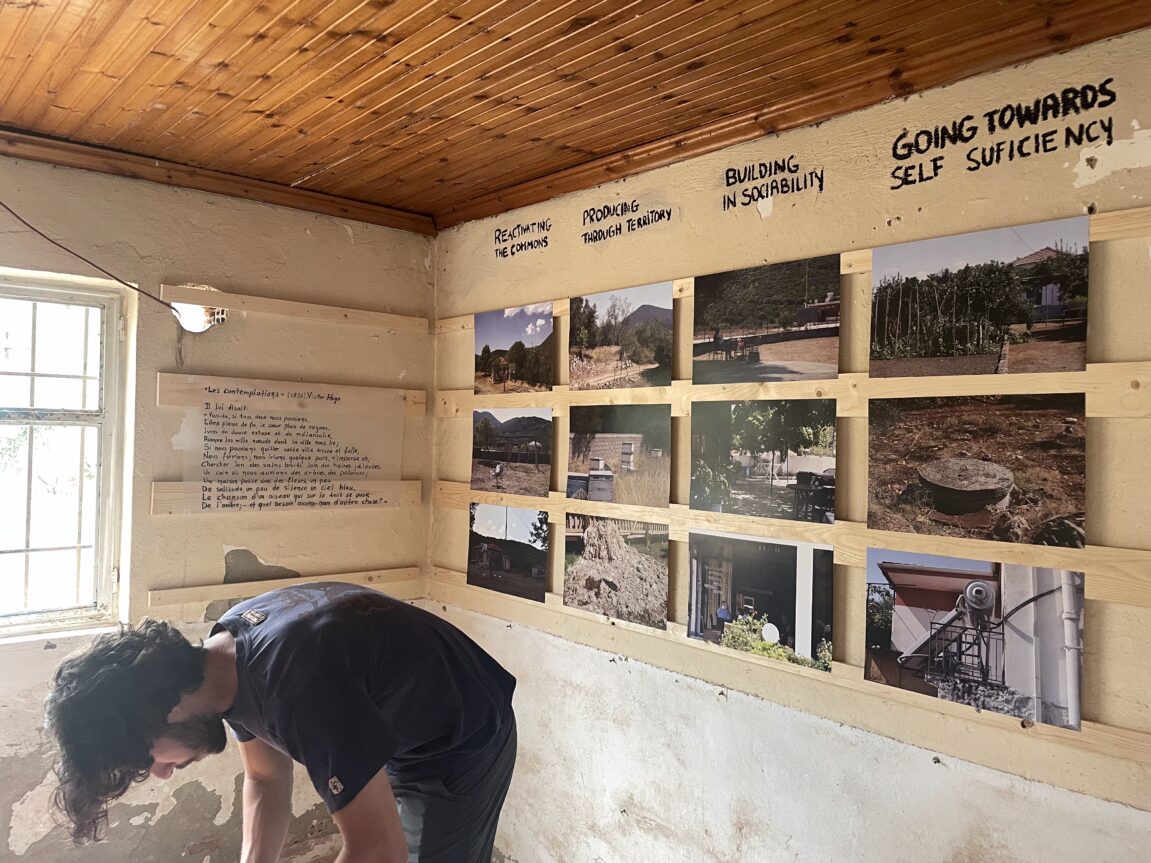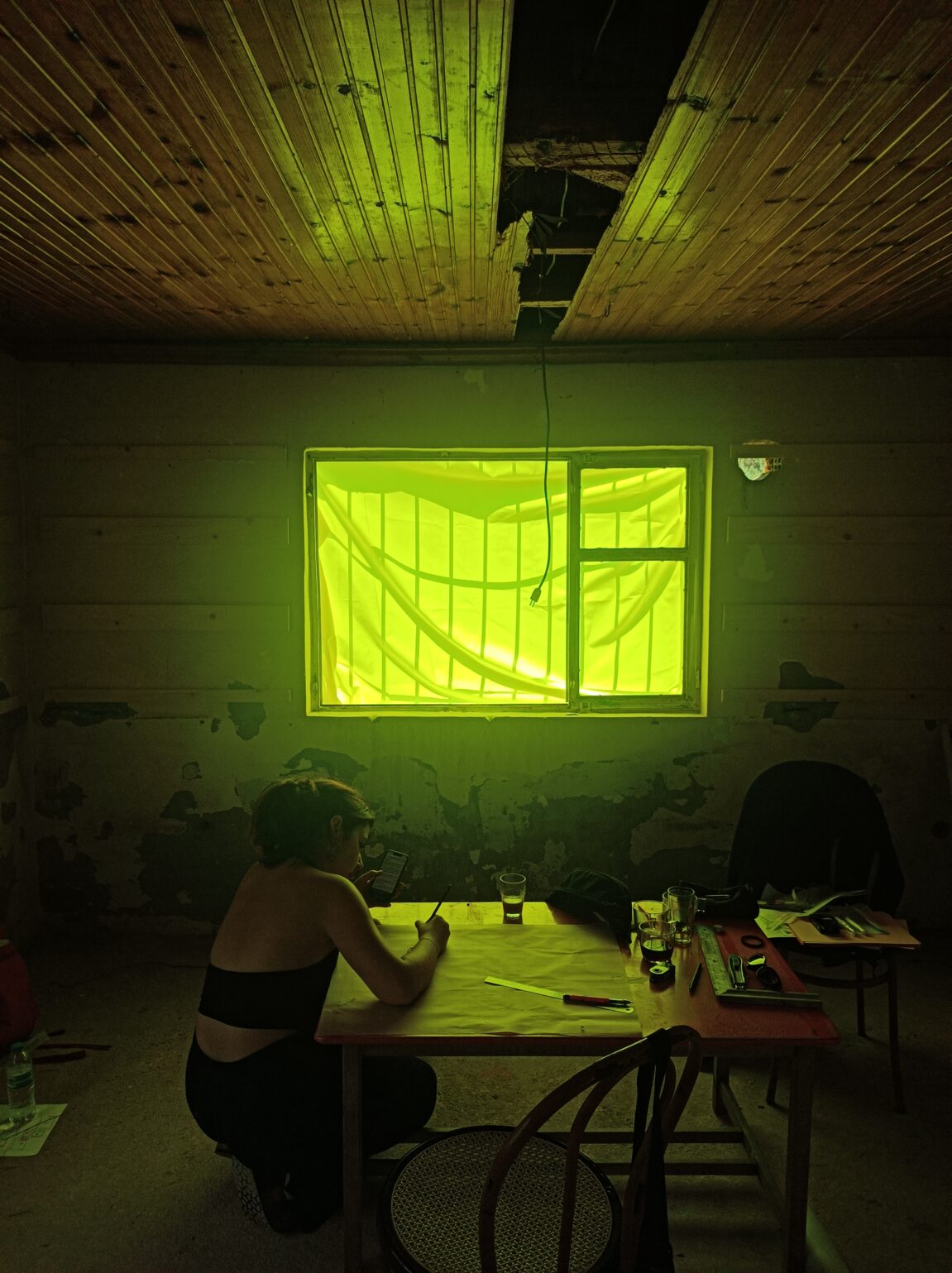Ambiguously beautiful,
with character,
oscillating between care and abandon,
she’s waiting for another life,
a life that is already here
if we allow ourselves a glimpse of it.
At a time when the question of (neo)rurality is being asked more and more in the face of socio-ecological crises, this exhibition aims to explore the specific features of rural areas, the resources they have at their disposal and the possibilities for life and development they offer – possibly in resonance with contemporary emergencies.
The exhibition is based on a 5-day exploration of the area by 7 architecture students. The territory is analysed by walking along a straight line (transect) and photographically capturing the artefacts present, complemented by a series of discussions with people living (more or less permanently) in the area.
Exhibition Overview
The exhibition is structured into five parts.
The first part is addressing territorial ambiguities, particularly the tensions between permanence and nomadism, as well as between conservation and overexploitation.
From coastal areas to rural countryside, dwelling retains its nomadic character, while landscapes experience conflicts between conserving and exploiting essential resources such as water and land. In this ongoing struggle, the untapped resources and beauty of rural regions, such as Thesprotia, are often overlooked.

The second part focuses on the key elements that characterize rural territories and the resources of the territory of Morphi.
Every territory has its resources. Self-sufficiency in food, local production, common spaces waiting for some caring, social networks… Once these have been identified and reactivated, the future possibilities begin to take shape.
“I want the running water faucet, the stream, which are my sweet old loves
to offer me a cure in their immortal waters.
I want the birds of the forest to lull me to sleep at night with their chirping,
to wake me up at dawn.
And I want to have as a mattress and a blanket the branches of trees to cover me in summer and the snow to cover me in the winter.
Twigs of wild yew, branches of fir trees, I want to build stacks of wood and lie on them in the shade, to listen to the sound of the rain and sleep sweetly.”
Kostas Kristallis, To the Booted Eagle (1893)
———————————————-
“He said to her :
‘You see, if only the two of us could,
The soul full of faith, the heart full of rays,
Drunk with sweet ecstasy and melancholy,
Break the thousand knots with which the city binds us;
If we could leave this sad and mad city,
We would flee; we would go somewhere, anywhere,
Far from vain noise, far from jealous hatred,
Somewhere with trees and lawns;
A small house with flowers,
A little solitude, a little silence, a blue sky,
The song of a bird that lands on the roof,
Shadow – and what need is there for anything else ?’”
Victor Hugo, Les contemplations, 1856


The third part addresses the future of the territory and is titled “The Morphi Charter for a Livable World”. Modern times have defined and framed the needs of the urban being (dwellin, work, circulation, leisure). The current situation, climate change, social injustices, political crisis lights up the need to rethink our ways of living.
We need to stop looking at things from an urban-centric perspective, just as we need to stop thinking in terms of rural/urban duality. In order to be able to imagine a rural “other growth” , it seems that we need to decentre ourselves from the urban-centric viewpoint and go beyond the rural/urban duality.
Morphis territory invite us to rethink of our “basic” needs, to redefine them.

Workshop Overview
The workshop explores the dynamics of (neo)rural questions, focusing on two main themes:
- Population Decline in Rural Areas:
- Analyze depopulation trends in rural areas across Europe.
- Investigate generational perceptions of rural life and the factors influencing individuals to stay or leave a territory.
- Rural Attractiveness Post-COVID:
- Study the increased interest in rural areas following the COVID-19 pandemic.
- Examine the phenomenon of “urban exodus” and the emergence of “neo-ruralities.”
Methodology
The study identifies material and immaterial territorial resources affecting residential choices.
- Water Issues:
Assess water’s significance in climatic, nutritional, recreational, and economic contexts. - Data Collection:
Combine interviews and photography to develop an inventory. Focus on interviewing young people connected to the village but only visiting during summer.
Planning
- Monday:
Conduct a transect walk—a linear exploration of the territory that documents spatial relationships through photos, drawings, and videos while fostering encounters with human and non-human elements (Robic, 2004; Tixier, 2016; Manola, 2020).


- Tuesday:
Begin a thematic inventory and conduct initial interviews using structured grids.
- Wednesday:
Conduct in-depth interviews to deepen understanding.
- Thursday:
Decide on presentation formats for the findings.


- Friday:
Finalize and organize the outputs.



